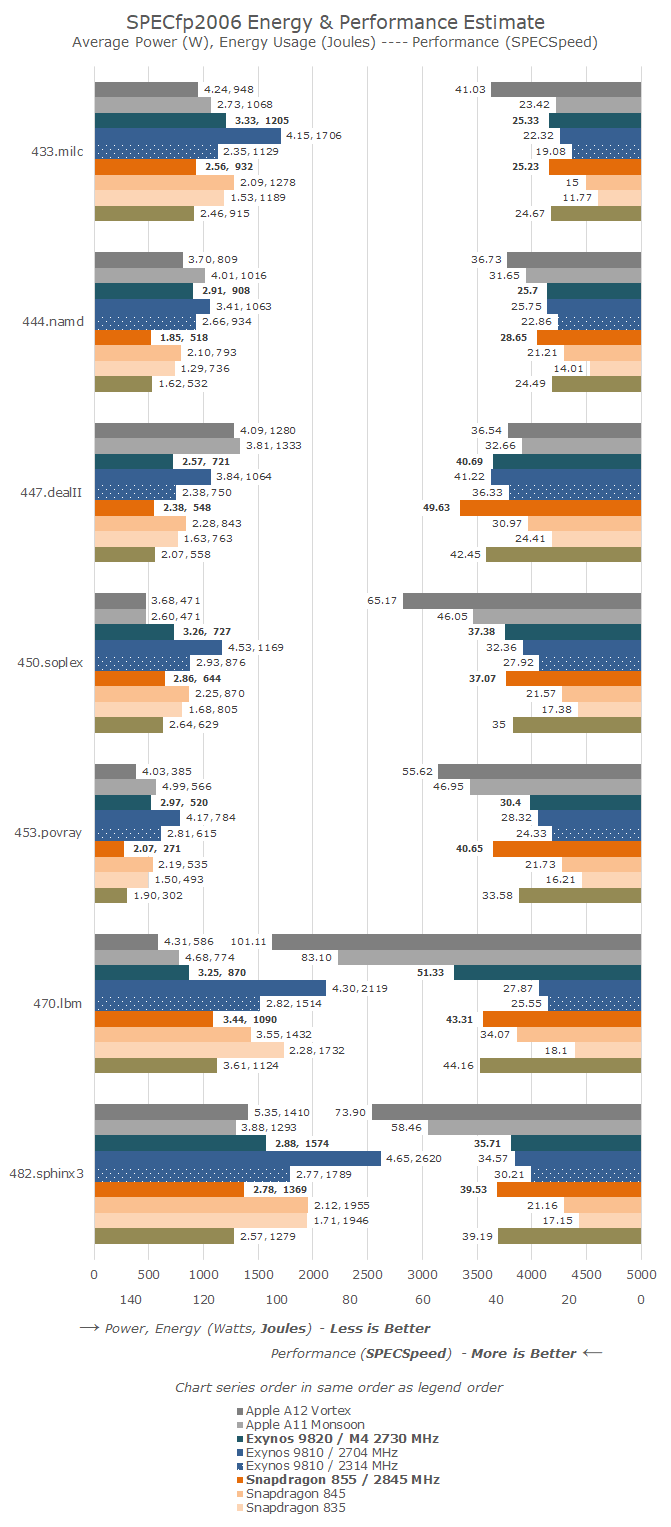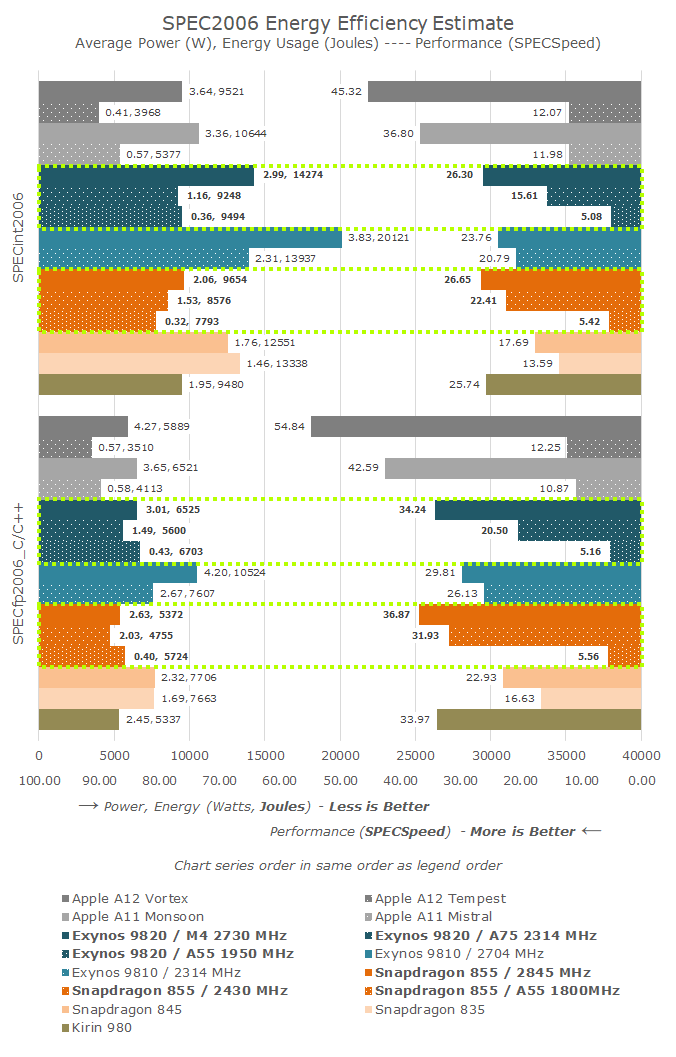The Samsung Galaxy S10+ Snapdragon & Exynos Review: Almost Perfect, Yet So Flawed
by Andrei Frumusanu on March 29, 2019 9:00 AM ESTSPEC2006: Performance Parity At Different Efficiency
Having shed a bit of light on the new microarchitectural aspects of the memory subsystems of the new Snapdragon 855 and Exynos 9820, the question is now how the new chipsets perform in more significant macro workloads. For a continued reference CPU workload we’re again falling back to using SPEC.
The SPEC harness we’re using is compiled with simple and straightforward “-Ofast” compilation flag with the Android devices having an instruction tuning to Cortex-A53s as I’ve found this to give the highest average scores across a the wide range of SoCs.
It’s to be noted that SPEC2006 has been deprecated in favour of SPEC2017, however as the 2006 variant is well understood in terms of its workload characterisation for this article I’m still sticking the older version. We’ll be switching over to SPEC2017 later this spring/summer and covering any new data in a separate article.
In the SPECint2006 suite of integer workloads, both chipsets don’t showcase any big surprises in performance. The new Snapdragon 855 variant of the Galaxy S10+ confirms the performance figures we were able to measure on the QRD platform back in January with little to no deviation. The Snapdragon posted excellent performance improvements over the Snapdragon 845 of last year and ties in with the Kirin 980 as the fastest Android SoCs for this year.
The Exynos 9820’s performance figures are also relatively unsurprising for me as I had muted expectations. Here we do see some relatively healthy performance improvements considering that we’re talking about mostly IPC gains on the part of the new Cheetah cores, as the new chipset is a mere 30MHz faster than last year’s chip.
The biggest improvements are found in 429.mcf as well as 471.omnetpp where the new M4 cores perform respectively 32% and 27% better. Both these workloads are the most latency and memory sensitive workloads in the SPECint2006 suite, so given the new chip’s improved memory subsystem it’s no wonder that it’s here where we see the biggest performance jumps. Mcf is also one of the rare tests where the Exynos manages to beat the Cortex A76’s in the S855 and K980 by a more significant amount. Unfortunately for the rest of the workloads being tied is the best-case scenario as it loses out by a small amount in all other workloads.
One thing that I have to note is that it’s possible that big parts of the benchmark probably weren’t run at the peak 2.73GHz clocks of the new M4 cores. Samsung has now enabled a current limiter circuit on the CPU cores and will now more aggressively throttle down the frequency of the CPU in high-power workloads. This means that needy workloads will only see the peak frequencies in the range of 5-10 seconds before throttling down to frequencies of 2.3-2.5GHz. I didn’t have time to have a more thorough monitoring of what the chip is doing during SPEC so it’s something I’ll have to follow up on.
When it comes to power efficiency, the new Exynos 9820 does improve notably compared to last year’s Exynos 9810. It seems that the biggest power efficiency improvements happened on the most memory intensive workloads, in particular 462.libquantum’s 74% efficiency improvement all while improving performance is quite impressive.
Having said that, as I had theorized back based on Samsung’s own marketing numbers, the efficiency gains just aren’t enough to actually compete against the 7nm Cortex A76 cores in the new Snapdragon and Kirin chipsets as Samsung’s chip loses out in every workload.
In the C/C++ workloads of SPECfp2006 we see a similar picture as in the integer workloads. The Snapdragon 855 distinguishes itself here as being able to distance itself more from the Kirin 980 in a few workloads such as 447.dealII and 453.povray, all while maintaining almost equal excellent power efficiency.
The Exynos 9820 here has a hard time showcasing big performance improvements compared to its predecessor, but the one workload where we see a massive jump is 470.lbm, with an 84% jump in performance compared to the M3 cores of last year. This workload is particularly latency and bandwidth intensive so the new load/store unit arrangement of the M4 cores seem to favour it a lot.
In terms of power efficiency, what is interesting is that the new Exynos doesn’t lose as badly as in some of the integer workloads, although it still very much loses to the Snapdragon and Kirin.
Again to have a wider range of performance comparison across ARMv8 cores in mobile here’s a grand overview of the most relevant SoCs we’ve tested:
Finally it’s important to have a wider overview of the performance and efficiency of the current generation chipsets:
In the SPECint2006 geomean score, the Exynos 9820 slightly loses out in the to the Snapdragon 855. More importantly, it uses 47% more energy and power to achieve this same performance. In SPECfp2006 this efficiency difference drops to 21% - although the performance on the M4 cores is also 7% less.
What is most interesting about the new Snapdragon 855 and Exynos 9820 chips is that they have multiple CPU groups, so I went ahead and also measured performance and power of the middle Cortex A76 cores of the Qualcomm chipset against the Cortex A75 cores of the Samsung silicon.
Unexpectedly, the Snapdragon chipset’s “middle” cores beat the Exynos’ middle cores by a hefty amount. At 2.4GHz, the three middle cores of the Snapdragon actually aren’t weak by any means, and only fall behind the Prime core by 15-19% in performance, for an 18% frequency deficit. The Cortex A75 cores on the Exynos chip are 35% weaker than the middle cores of the Snapdragon. Here a more even comparison probably would have been the 1.92GHz middle A76 cores of the Kirin 980, however I wasn’t able to benchmark them separately on Huawei’s devices.
Energy efficiency of Samsung’s A75 cores are good – although it comes at a larger performance deficit, they’re in line with the energy consumption of the A76 cores in the competition.
In the quest to find an answer on how much the actual process node impacts power efficiency between the 7nm Snapdragon and 8nm Exynos, I also went ahead and ran SPEC on the Cortex A55 cores of both chipsets. After a gruelling 11.5 hours of runtime we finally see that the little cores only post a fraction of the performance of the big core siblings. What is actually quite embarrassing though is that the power efficiency is also quite atrocious for the given performance. Here other blocks of the SoC as well as other active components are using up power without actually providing enough performance to compensate for it. This is a case of the system running at a performance point below the crossover threshold where racing to idle would have made more sense for energy.
Apple’s small cores are just such an incredible contrast here: Even though the absolute power isn’t that much bigger than the Cortex A55 cores, the Tempest and Mistral cores are 2.5x faster than an A55, which also results in energy efficiency that is around 2x better.
Finally getting back to the reason why I measured the A55 cores: The Exynos 9820 here again loses out not only in performance but also in power efficiency. Even though the chip’s A55 cores are clocked in higher at 1.95GHz, it’s likely the lack of L2 caches is handicapping the CPUs in IPC, and thus falls behind the 1.78GHz Snapdragon A55’s. Power efficiency here is better on the Snapdragon SoC by 15-18%.
During last summer’s Hot Chips presentation of the M3 CPU core Samsung had remarked to me that the M4 would be the competing against the Cortex A76, and not the M3. While in terms of power efficiency there’s the matter of us not having a valid apples-to-apples process node comparison at hands, at least from a performance perspective it doesn’t look like the new M4 cores are all that impressive, as they just barely manage hold up against the A76 in the Snapdragon and Kirin. Samsung’s CPU just looks to still have too many rough edges and bottlenecks, and thus ends up performing far below of what we’d expect of a microarchitecture that fundamentally on paper is wider than Arm’s Cortex A76.














229 Comments
View All Comments
luca.costantino - Friday, March 29, 2019 - link
Way too much bloatware on Samsung products for my taste. I would never consider buying a phone from them.shabby - Friday, March 29, 2019 - link
Are you offended or something? That's the dumbest comment I ever read, I just sold an s9 and wiped it, the buyer said I thought it would have more bloatware but it doesn't.liteon163 - Friday, March 29, 2019 - link
No need to be so harsh simply because you disagree with someone's opinion, dude. Don't be a jerk (that's not an opinion, that's a FACT proven by your initial reply).close - Sunday, March 31, 2019 - link
Samsung has their own equivalent of every single piece of software that comes with Android and you already didn't want in your phone. @shabby just wanted to tell us he knows how to follow a decrapify tutorial. The phone is still crappy software-wise but after putting in a lot of effort you can make it marginally less crappy. Yay?Vermite - Sunday, May 19, 2019 - link
You're an idiot. Yay?s.yu - Sunday, March 31, 2019 - link
There are smarter opinions and stupider opinions.goatfajitas - Friday, March 29, 2019 - link
Yes, it does have alot of bloat.mazook - Friday, March 29, 2019 - link
Dude, the ROM is about 4 GIGS.Think there's just a BIT of bloat in there?
Samus - Sunday, March 31, 2019 - link
I figured Android users are just used to bloat at this point. I’d you want a clean optimized mobile experience you either buy a Google phone, install a 3rd party ROM, or just buy an iPhone.notashill - Monday, April 1, 2019 - link
The "bloatware free" Android One ROMs are like 12 gigs though they do keep 2 entire copies of the system partition for the seamless update feature. Very annoying especially considering how many Android One devices have 32GB storage.